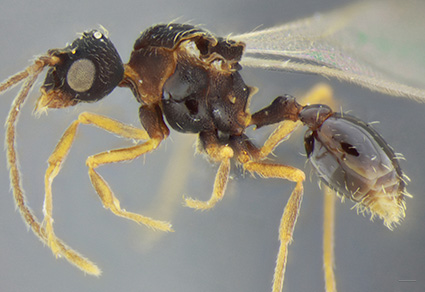Abstract
Eurhopalothrix reichenspergeri (Santschi, 1923) stat. rev. is resurrected from synonymy with E. gravis (Mann, 1922). In Brown & Kempf’s tribal basicerotine revision of 1960, Rhopalothrix reichenspergeri was transferred to the genus Eurhopalothrix and synonymized into the species E. gravis. Eurhopalothrix gravis became, from that moment until now, the species with the largest distribution in the genus. After the present work, E. gravis has a Central American and north South American (Colombia) distribution, while E. reichenspergeri is restricted to the Brazilian Atlantic Forest. A key to the workers of the southern South American Eurhopalothrix species is provided. The male of E. reichenspergeri is described and compared to the male of E. gravis, E. floridana Brown & Kempf, 1960 and the putative male of E. spectabilis Kempf, 1962.
References
Aibekova, L., Boudinot, B., Beutel, R., Richter, A., Keller, R., Hita-Garcia, F. & Economo, E. (2022) The Skeletomuscular System of the Mesosoma of Formica rufa Workers (Hymenoptera: Formicidae). Insect Systematics and Diversity, 6 (2), 1–26. https://doi.org/10.1093/isd/ixac002
AntWeb (2022) AntWeb, California Academy of Sciences, San Francisco, California, USA. Available from: http://www.antweb.org (accessed 21 May 2022)
Baroni Urbani, C. & De Andrade, M.L. (1994) First description of fossil Dacetini ants with a critical analysis of the current classification of the tribe (Amber Collection Stuttgart: Hymenoptera, Formicidae. VI: Dacetini). Stuttgarter Beiträge zur Naturkunde. Serie B (Geologie und Paläontologie), 198, 1–65.
Baroni Urbani, C. & De Andrade, M.L. (2007) The ant tribe Dacetini: limits and constituent genera, with descriptions of new species (Hymenoptera, Formicidae). Annali del Museo Civico di Storia Naturale "Giacomo Doria", 99, 1–191.
Bolton, B. (1998) Monophyly of the dacetonine tribe-group and its component tribes (Hymenoptera: Formicidae). Bulletin of the Natural History Museum London (Entomology), 67, 65–78.
Bolton, B. (2003) Synopsis and classification of Formicidae. Memoirs of the American Entomological Institute, 71, 1–370.
Bolton, B. (2022) An online catalog of the ants of the world. Available from: https://antcat.org (accessed 9 June 2022)
Boudinot, B.E. (2015) Contributions to the knowledge of Formicidae (Hymenoptera, Aculeata): a new diagnosis of the family, the first global male-based key to subfamilies, and a treatment of early branching lineages. European Journal of Taxonomy, 120, 1–62. https://doi.org/10.5852/ejt.2015.120
Brown, W.L. Jr. & Kempf, W.W. (1960) A world revision of the ant tribe Basicerotini. Studia Entomologica, New Series, 3, 161–250.
Brown, W.L. Jr. & Kempf, W.W. (1961 [apparent year 1960]). The type species of the ant genus Eurhopalothrix. Psyche, Cambridge, 67, 44. https://doi.org/10.1155/1960/61430
Camacho, G. & Vasconcelos, H. (2015) Ants of the Panga Ecological Station, a Cerrado Reserve in Central Brazil. Sociobiology, 62 (2), 281–295. https://doi.org/10.13102/sociobiology.v62i2.281-295
Deyrup, M., Johnson, C., Davis, L. (1997) Notes on the ant Eurhopalothrix floridana, with a description of the male (Hymenoptera: Formicidae). Entomological News, 108, 183–189.
Fernández, F. & Serna, F.J. (2019) Subfamilia Myrmicinae. Capítulo 27. In: Fernández, F., Guerrero, R.J. & Delsinne, T. (Eds.), Hormigas de Colombia. Universidad Nacional de Colombia, Bogotá, pp. 791–888.
Fiorentino, G., Tocora, M.C. & Fernández, F. (2022) A new species of small myrmicine ant in the genus Eurhopalothrix Brown & Kempf, 1961 (Hymenoptera: Formicidae) from Colombia. Revista Colombiana de Entomología, 48 (1), 1–6. https://doi.org/10.25100/socolen.v48i1.11484
Guénard, B., Weiser, M., Gomez, K., Narula, N. & Economo, E.P. (2017) The Global Ant Biodiversity Informatics (GABI) database: a synthesis of ant species geographic distributions. Myrmecological News, 24, 83–89. https://doi.org/10.25849/myrmecol.news_024:083
Janicki, J., Narula, N., Ziegler, M., Guénard, B. & Economo, E.P. (2016) Visualizing and interacting with large-volume biodiversity data using client-server web-mapping applications: The design and implementation of antmaps.org. Ecological Informatics, 32, 185–193. https://doi.org/10.1016/j.ecoinf.2016.02.006
Keller, R.A. (2011) A phylogenetic analysis of ant morphology (Hymenoptera: Formicidae) with special reference to the poneromorph subfamilies. Bulletin of the American Museum of Natural History, 355, 1–90. https://doi.org/10.1206/355.1
Kempf, W.W. (1962) Miscellaneous studies on neotropical ants. II. (Hymenoptera, Formicidae). Studia Entomologica, 5, 1–38.
Kempf, W.W. (1967) Three new South American ants (Hym. Formicidae). Studia Entomologica, 10, 353–360.
Kempf, W.W. (1968) Miscellaneous studies on Neotropical ants. IV. (Hymenoptera, Formicidae). Studia Entomologica, 11, 369–415.
Ketterl, J., Verhaagh, M. & Dietz, B.H. (2004) Eurhopalothrix depressa sp. n. (Hymenoptera: Formicidae) from southern Brazil with a key to the Neotropical taxa of the genus. Studies on the Neotropical Fauna and Environment, 39, 45–48.
https://doi.org/10.1080/01650520412331270954
Kimball, S. & Mattis, P. (1996) GIMP—The GNU Image Manipulation Program. Available from: https://www.gimp.org (accessed 30 May 2021)
Longino, J.T. (2013). A review of the Central American and Caribbean species of the ant genus Eurhopalothrix Brown and Kempf, 1961 (Hymenoptera, Formicidae), with a key to New World species. Zootaxa, 3693 (2), 101–151.
https://doi.org/10.11646/zootaxa.3693.2.1
Luebert, F. (2021) The Two South American dry diagonals. Frontiers of Biogeography, 13 (4), e51267. https://doi.org/10.21425/F5FBG51267
Mann, W.M. (1922) Ants from Honduras and Guatemala. Proceedings of the United States National Museum, 61, 1–54. https://doi.org/10.5479/si.00963801.61-2434.1
Omar, M.B., Bolland, L. & Heather, W.A. (1979) A permanent mounting medium for fungi. Bulletin of the British Mycological Society, 13 (1), 13–32.
https://doi.org/10.1016/s0007-1528(79)80038-3
QGIS Development Team, 2009. QGIS Geographic Information System. Open Source Geospatial Foundation. Available from: http://qgis.org (accessed 18 July 2022)
Santschi, F. (1923) Descriptions de quelques nouvelles fourmis du Brésil. Revista do Museu Paulista, 13, 1255–1264.
Schneider, C.A., Rasband, W.S. & Eliceiri, K.W. (2012) NIH Image to ImageJ: 25 years of image analysis. Nature Methods, 9, 671–675. https://doi.org/10.1038/nmeth.2089
Silva, R.R. & Brandão, C.R.F. (2014) Ecosystem-Wide Morphological Structure of Leaf-Litter Ant Communities along a Tropical Latitudinal Gradient. PLoS ONE, 9 (3), e93049. https://doi.org/10.1371/journal.pone.0093049
Snelling, R.R. (1968) A new species of Eurhopalothrix from El Salvador (Hymenoptera: Formicidae). Contributions in Science, Los Angeles, 154, 1–4. https://doi.org/10.5962/p.241142
Ward, P.S., Brady, S.G., Fisher, B.L. & Schultz, T.R. (2015) The evolution of myrmicine ants: phylogeny and biogeography of a hyperdiverse ant clade (Hymenoptera: Formicidae). Systematic Entomology, 40, 61–81. https://doi.org/10.1111/syen.12090


